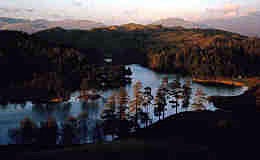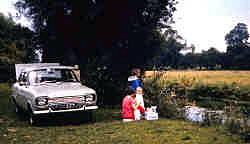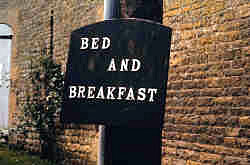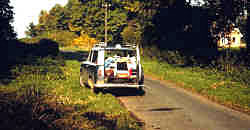| From Moreton station, it's only one block
to the village center and pleasant shops and tea rooms, small restaurants and comfortable
hotels. If you arrive on Tuesday, you can wander through one of the best weekly markets in
the region. If you prefer tranquillity to the bustle of market, take the footpath north of
the village toward Bourton-on-the-Hill. But that's about as far as you will venture
from the train station. If you're traveling by rail, you will miss Stow-on-the-Wold, Upper Swell, Lower Slaughter, Bourton-on-the-
Water, Shipton-Under- Wychwood, Great Tew, Little Compton and Chipping Campden. To see
the north Cotswolds, and indeed rural Britain in general, you must stiffen your
back, grit your teeth, rent a car and drive. Stow-on-the-Wold, Upper Swell, Lower Slaughter, Bourton-on-the-
Water, Shipton-Under- Wychwood, Great Tew, Little Compton and Chipping Campden. To see
the north Cotswolds, and indeed rural Britain in general, you must stiffen your
back, grit your teeth, rent a car and drive.
Now, most Americans balk at the prospect of driving a car with the steering wheel on
the wrong side. Many who decide nevertheless to give it a try are terrified when they are
first poised to enter a flow of traffic streaming down the wrong side of the road.
Not me. I have lived my life in a right-handed society that only just tolerates
left-handers. So I escape as often as I can to a land where the virtues of the left are
paramount. The British walk on the left, and--bless them--they drive on the left.
It wasn't easy, even for a left-hander, to make the adjustment. Just as my kindergarten
teacher tried to persuade me by subtle pressures to adopt the correct right hand, I had to
adjust to the correct left-handedness of British driving.
Elated as I was at my first opportunity to enter the rational world of British driving,
I was careful. I arranged to pick up my rental car at the most distant tube stop in north
London. I would then, I thought, have a straight shot to the country.
Wrong. The rental agency was on the busiest street in north London, which was at the
moment of my arrival filled with four lanes of fast-moving traffic. My car was parallel
parked at the curb. I opened the door on the left side, then fumbled in the glove
compartment so anyone watching would not think that I had opened the wrong door. I closed
the door and walked around to the driver's side and slipped behind the wheel. I started
the engine, tested the brake, accelerator and clutch. I turned the wheels to the right,
raced the engine, found a break in the flow of traffic, let out the clutch to shoot out
into the flow, and smashed into the van parked directly in front of me. Only then did I
see the large fellow sitting at the wheel of the van, which was facing my car.
I reversed the car slowly until I was parked again at the curb. I got out of the car
even more slowly. The van driver sat for a moment longer, then got out. We walked together
to observe the damage. My car appeared untouched, but I had destroyed his headlight and
crushed the side of his grill. We looked at each other.
"First time?" he asked.
I wasn't sure whether he meant "driving in Britain" or "driving."
"Yes," I said. He smiled, much to my relief.
"Why don't you be on your way, and I'll take care of this." It was the rental
agent who had stepped out of his office
 when
he heard the crash. I remembered that just a moment ago in his office I had decided to pay
an extra daily fee to add the collision damage waiver. I thanked him. The large van driver
shook my hand, wished me good luck and gave me a pat on the shoulder as I turned to go.
The expression, "Baptism By Fire," had new meaning for me. when
he heard the crash. I remembered that just a moment ago in his office I had decided to pay
an extra daily fee to add the collision damage waiver. I thanked him. The large van driver
shook my hand, wished me good luck and gave me a pat on the shoulder as I turned to go.
The expression, "Baptism By Fire," had new meaning for me.
Happily, my experience is not a required initiation into British driving. The first
thing to remember, and to keep repeating for the first few days, is that the bulk of the
car is on the left side of the driver, not the right as in American cars. Keeping that
fact in mind will help you remember to drive on the left side of the road. The most likely
place that you will forget is during a turn. If you keep saying to yourself, "left
side, left side," then you should have no trouble in completing the turn on the left
side of the street.
Watch out for the roundabouts. This brilliant alternative to the four-way stop can be
confusing until you become familiar with it. First of all, avoid the temptation to speed
around the circle counter-clockwise. Remember: "left side, left side." Stop at
the edge of the circle, and look right. Traffic already in the roundabout has the right of
way. When you see a break, enter the flow slowly, keeping in mind that other vehicles will
be trying to edge into the left lane to exit. This is especially important when you are
not exiting at the next street.
If others are riding with you, encourage back-seat driving. Passengers are going to be
on the edge of their seats anyway, until they begin to have confidence in your left-handed
skills. Welcoming their cautions will let them share the learning experience and the
terror.
Since your purpose is to see the country, stay off the motorways. Drive the
"A" and "B" roads, even the unmarked routes, assuming that you have a
detailed local map. Roads with only one lane, marked "Single Track," are risky.
That's one lane, not one lane each way. Some locals drive these paved paths as if
they were closed race courses. They can be especially dangerous if high hedges block the
view around curves or corners. British drivers in the countryside tend to be considerate,
but the passing places never seem to be in the right place at the right time.
This is not to say that the British are not aggressive. Most "A" and
"B" roads have only one lane in each direction. By American standards, the lanes
are narrow, and there is usually no shoulder. More
often than not, the edge of the road is a cobblestone curb about three inches high. While
tourists of any nationality tend to drive casually, British locals drive fast, follow
close enough to read your dash instruments, and pass on hills and curves. Above all else,
remember this: if you round a curve and see a car ahead in your lane, coming at you,
squeeze left, not right. usually no shoulder. More
often than not, the edge of the road is a cobblestone curb about three inches high. While
tourists of any nationality tend to drive casually, British locals drive fast, follow
close enough to read your dash instruments, and pass on hills and curves. Above all else,
remember this: if you round a curve and see a car ahead in your lane, coming at you,
squeeze left, not right.
Off the busy roads, the pace and pulse are slower. The winding lanes between the
smaller villages are the least crowded and the most pleasant to drive. It is not unusual
to see a car parked in a layby or on the verge, with folding chairs and table nearby,
spread neatly with a cloth and afternoon tea. Since you won't likely be so equipped, don't
fail to stop in a village tea room for a nice respite.
My family and I stopped beside a narrow lane one day for a picnic lunch. The grass was
still moist from an overnight rain, but we found a log at the edge of the wood to sit on
and enjoyed our sandwiches and the spring sunshine. When we finished, we climbed into the
car. I started the engine and put the car in gear, but it would not move. The tires simply
spun.
I got out and saw that the rear tires had sunk about four inches into the mud. What I
had thought was a grassy hard surface was really a camouflaged quagmire. I tried rocking
the car back and forth, stripping gears in both directions. With my wife in the driver's
seat, I pushed while she spun the wheels and sprayed mud on my pants.
A car drove up slowly from behind and stopped in the middle of the lane. A man opened
the door and
 stepped out. He was dressed in a neat tweed
suit. "Trouble?" he asked. Without waiting for a reply, he went to the back of
his car, opened the trunk and took out a pair of rubber boots and a shovel. While I
watched, he pulled on the boots and came over with the shovel. He dug a few spadefuls from
the front of each of the back tires, then filled the cavities with rotted bark and gravel
from the roadside. stepped out. He was dressed in a neat tweed
suit. "Trouble?" he asked. Without waiting for a reply, he went to the back of
his car, opened the trunk and took out a pair of rubber boots and a shovel. While I
watched, he pulled on the boots and came over with the shovel. He dug a few spadefuls from
the front of each of the back tires, then filled the cavities with rotted bark and gravel
from the roadside.
"Now try it," he said. "Gently." I tried it, gently, and the car
rolled slowly onto the road. I thanked him and pumped his hand.
"Not much you can't do with Wellies and a good shovel," he said. He pulled
off the boots and threw them and the shovel into the back of his car and drove off.
I drove ahead and turned into the "A" road, mumbling "left side, left
side."
This article published in International Travel News (March 1997).
Write to the
author.
Caveat and disclaimer: This is a freelance travel article that I published some
time ago. Some data may not be current.
|
 Stow-on-the-Wold, Upper Swell, Lower Slaughter, Bourton-on-the-
Water, Shipton-Under- Wychwood, Great Tew, Little Compton and Chipping Campden. To see
the north Cotswolds, and indeed rural Britain in general, you must stiffen your
back, grit your teeth, rent a car and drive.
Stow-on-the-Wold, Upper Swell, Lower Slaughter, Bourton-on-the-
Water, Shipton-Under- Wychwood, Great Tew, Little Compton and Chipping Campden. To see
the north Cotswolds, and indeed rural Britain in general, you must stiffen your
back, grit your teeth, rent a car and drive. when
he heard the crash. I remembered that just a moment ago in his office I had decided to pay
an extra daily fee to add the collision damage waiver. I thanked him. The large van driver
shook my hand, wished me good luck and gave me a pat on the shoulder as I turned to go.
The expression, "Baptism By Fire," had new meaning for me.
when
he heard the crash. I remembered that just a moment ago in his office I had decided to pay
an extra daily fee to add the collision damage waiver. I thanked him. The large van driver
shook my hand, wished me good luck and gave me a pat on the shoulder as I turned to go.
The expression, "Baptism By Fire," had new meaning for me.  usually no shoulder. More
often than not, the edge of the road is a cobblestone curb about three inches high. While
tourists of any nationality tend to drive casually, British locals drive fast, follow
close enough to read your dash instruments, and pass on hills and curves. Above all else,
remember this: if you round a curve and see a car ahead in your lane, coming at you,
squeeze left, not right.
usually no shoulder. More
often than not, the edge of the road is a cobblestone curb about three inches high. While
tourists of any nationality tend to drive casually, British locals drive fast, follow
close enough to read your dash instruments, and pass on hills and curves. Above all else,
remember this: if you round a curve and see a car ahead in your lane, coming at you,
squeeze left, not right.  stepped out. He was dressed in a neat tweed
suit. "Trouble?" he asked. Without waiting for a reply, he went to the back of
his car, opened the trunk and took out a pair of rubber boots and a shovel. While I
watched, he pulled on the boots and came over with the shovel. He dug a few spadefuls from
the front of each of the back tires, then filled the cavities with rotted bark and gravel
from the roadside.
stepped out. He was dressed in a neat tweed
suit. "Trouble?" he asked. Without waiting for a reply, he went to the back of
his car, opened the trunk and took out a pair of rubber boots and a shovel. While I
watched, he pulled on the boots and came over with the shovel. He dug a few spadefuls from
the front of each of the back tires, then filled the cavities with rotted bark and gravel
from the roadside.